|
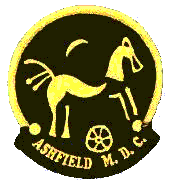
| |
“AY-THANG -YEW”

|
Gavin Phillips proudly
displays his first ever hammered coin
|
|
 |
|
FIND
OF THE MONTH JUNE, 2010.
COIN:-
John Wilkinson, Queen Ann, 1710
two-pence.
ARTEFACT:- Mary
Severn, medieval chape
|
|

John Wilkinson,
Queen Ann, 1710 two-pence |

Mary Severn, medieval chape |
|
|
|
FIND OF THE MONTH
JULY, 2010.
COIN:-
Joint, Dennis Brown Victoria
shilling. Dave Rhodes, Edward 111 penny.
ARTEFACT:-
Ivan Falconbridge, gold and diamond
ring.
|
|
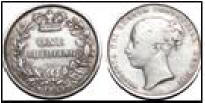
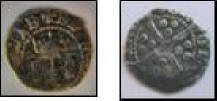
Dennis Brown
joint with
Dave Rhodes
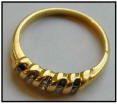
Ivan Falconbridge. |
|
FIND
OF THE MONTH AUGUST, 2010.
COIN:-
Graham Reedman. Tealby penny.
ARTEFACT:-
Joint, Terry Hurt ring. Ivan
Falconbridge silver bangle.
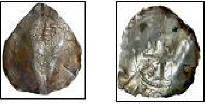

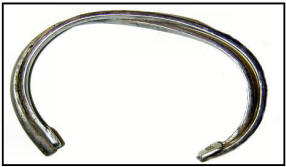
Graham Reedman
Terry Hurt
Ivan Falconbridge
|
|
FIND
OF THE MONTH, SEPTEMBER, 2010.
COIN:-
John Wilkinson. Trajan denarius
ARTEFACT:-
David Rhodes, seal.


John Wilkinson.
Dave Rhodes
|
|
MOST UNUSUAL FIND OF THE MONTH
It was decided by club members to
make a new category of finds to be included in the Find of the Month
awards it is “The Most Unusual Find of the Month” there will a
certificate for the winner but no cash prize.
JULY, 2010.
John Radford for his pipe stem
AUGUST, 2010,
John Radford for his “Pigmy Slave Bangle” or Wotsit”.
SEPTEMBER,
2010, John Gough, for his cattle ear tag.



John Radford
John Radford
John Gough. |
|
OTHER FINDS SINCE THE LAST NEWSLETTER |
| RING

June Reedman
|
WHISTLE

Gavin Phillips |
BADGE

John Radford |
 |
TERRET RING
Found by Andy Belton and Jeff Oscroft in two parts on the same
search.
A terret ring was used on war chariots to guide the reins.
Period 100BC
- 100AD. |
|
 |
ROMAN BALSAMARIUM OR OIL
LAMP LID.
Derek Battle found this artefact on a club search. He did
not identify it at the time. John Radford was looking
through “ Celtic and Roman Artefacts” by Nigel Mills when he
discovered on page 118 item R365 an image of a very similar
artefact, this one also has a sitting duck ornament on it.
|
|
RING |
JAMES1 PENNY |
GEORGE 111 SHILLING |
|
 |
 |
 |
|
Ivan Falconbridge |
Dennis Brown |
John Radford |
| |
|
|
|
ROMAN BROOCH |
CUT HALFPENNY |
STATUE |
|
 |

Jeff Oscroft. Cut halfpenny of either Stephen or
Matilda. Which one? The jury is still out.
|
 |
|
Jeff Oscroft |
Jeff Oscroft |
Terry Hurt |
|
***
CONGRATULATIONS TO JONATHON BRYANT.
“Jono” has passed his full first aid
requalification.
The qualification is for three years.
*** |
|
EYES DOWN -
LOOK IN! |
|
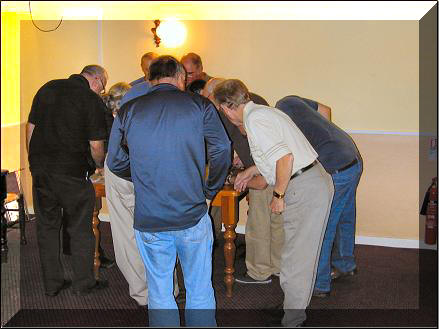 |
|
WHAT’S THE BIG
ATTRACTION?
No it’s not free
food! It’s the entries for the September Find of
the Month competition!
*** |
|
CLUB
LOOK-ALIKES |
|

| |
 |
ASHFIELD M D C FAMOUS
LOOK-ALIKES.
Dave Hallam has provided these
look-alike images for the
newsletter. He said they were
sent to him by a club member
with too much time on his/her
hands and wishes to remain
anonymous to avoid any libel
actions!
*** |
|
|
A SMALL
DISPLAY OF CROTAL BELLS IN A CIGAR BOX
|
 |
Crotal bells, or rumbler bells have been
in use for centuries. They have been
worn by horses, cattle, sheep and even
children. The “Bell-weather” or leader
of a flock of sheep would wear the bell,
hence the name. The display case shown
here was made by John Gough, it is just
a cigar box with a floor of quarter inch
polystyrene board on which the bells are
arranged and stuck in place with double
sided carpet tape. A descriptive card is
fixed in the lid with blue tack.. The
collection shown here is of undamaged
bells found metal detecting in
Nottinghamshire over the past 32 years.
Each one is tagged on the back with a
code indicating where it was found.
Most of the bells in the collection
still ring when shaken
Whilst on holiday in Cyprus a few years
ago, I visited the Ethnographical
Museum in Paphos, there I saw a case of
five bells of a very similar design. The
museum owner told me he had excavated
them from local sites, some dating to
before Christ. I sent him two bells to
add to his display. I still wonder about
the age and origin of the bells that do
not have makers marks or decoration that
are found in the British Isles. |
|
 |
|
*** |
|
EXTRACTS FROM THE NOTTINGHAM AND
DISTRICT YEAR BOOK 1750.
The following is for the year 1750
and gives a flavour of what travel
would be like, describing the state
of the roads, the large amount of
forest and how dangerous travel was
in those days. It is hoped that it
may assist the metal detectorist to
form an idea in his/her mind of
where casual losses may have been
made. The
roads were in such an execrable
state, as with few exceptions, not
to be passable for a cart, or other
wheeled vehicle. Consequent on this,
the internal trade of the island had
to be carried on by means of
packhorses, and a few navigable
rivers, the very idea of canals a
good macadamised roads being deemed
highly problematical. Lines of
horses or mules, each from a dozen
to thirty or forty in number, the
first having a bell, conveyed
through long winding lanes a large
part of the merchandise the trader
or merchant, who in most cases
accompanied his pack, received his
balances in guineas, which, with a
pair of loaded pistols, he carried
in his saddle-bag. On the principal
highways, where passable, heavy and
cumbrous vehicles were used, as an
improved means of locomotion. These
clumsy contrivances were made very
strong, to resist injury from the
dangerous inequalities of the roads,
and carried no passengers on the
roof but each had a large
basket—literally a basket—swung
behind, for half-price passengers.
The coachman had four horses in
hand, and a postilion rode a pair of
leaders. Three miles an hour,
including stoppages, was thought a
good pace, and four, a wonderment.
There were also road-waggons,
travelling at a still slower rate,
as cumbrous and ugly as the mind can
well conceive.
So
defective were the roads in the
Midland counties, that, up to about
this period, they were generally of
the most primitive kind—rude, rutty,
and abominable. Even in the
neighbourhood of Nottingham, some of
them were at times impassable in
vehicles of any description; and in
the winter months, it happened not
infrequently, that waggons and
coaches stuck in the mud, and were
left there till extrication became
more easy. In 1749, William Hutton,
the Birmingham historian, who gained
a precarious subsistence in
Nottingham as a bookseller, attended
Southwell on market-days, whenever
practicable. He represents the road
[now one of the best in the county]
as " despicable," and as taking him
five hours to traverse the fourteen
miles, though a good pedestrian. In
one of these journeys he describes
himself as meeting in the Forest,
four deer-stealers returning with a
buck, and being put in fear lest he
should be knocked on the head to
keep silence. The Forest, it may be
remarked at this point, retained
much of its pristine glory, and the
road from Nottingham to Mansfield
passed through what was for the most
part, in spite of large enclosures,
one continued wood. The road to
Loughborough, long in a most
dangerous and impassable state,
having recently been the subject of
extensive repairs, was decidedly in
the best condition of any.
The
Trent, however, was the great
highway for goods and merchandise.
The town was supplied through its
medium with bar-iron, block-tin,
wines, oils, groceries, salt, tar,
hops, hemp, flax, drugs, and foreign
timber; and in return, sent coal,
lead, timber, corn, wool,
potters-ware, and large quantities
of Cheshire, Warwickshire, and
Staffordshire cheese …...to
be continued if wanted.
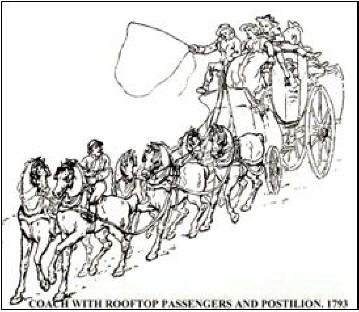
*** |
|
THE MARIE THERESA
THALER
by Dave Hallam.
Maria Theresa was born in on May
13, 1717, as daughter of Emperor
Charles IV and his wife,
Elisabeth von
Braunschweig-Wolfenbuettel. She
succeeded her father in 1740 at
the age of 23. She was Queen of
Hungary and Bohemia and
Archduchess of Austria. Maria
Theresa's father had tried to
guarantee the female succession
through the Pragmatic Sanction.
Unfortunately, not everyone
agreed to this idea, leading to
the War of the Austrian
Succession against Frederick of
Prussia and his allies.
Internally her reign was marked
by great reforms in the areas of
justice, finance, education and
medicine. Maria Theresa created
the foundations of the modern
state.
In 1736, Maria
Theresa married Francis Stephen
of Lorraine. With him, she had
16 children. Francis Stephen was
an able businessman, but he had
little political ambition. Even
after he became the emperor, he
preferred to leave the business
of governing to his wife. He
died in 1765 and was succeeded
by his son Joseph II, who became
the co-regent with his mother,
Maria Theresa. Maria Theresa
died on November 29, 1780, at
the age of 63. The literature
often refers to Maria Theresa as
an Empress. In reality she only
had this title as the spouse of
Emperor Franz I from 1745, when
he was elected Holy Roman
Emperor, until he died in 1765.
She herself was never elected
Empress, due to the Salische
Gesetz, which only accepted
succession to the male heir.
On September 21, 1753, Maria
Theresa and the Duchy of Bavaria
signed a coinage convention.
This treaty defined the exact
weight and silver content of
every silver coin to be struck
in Austria and Bavaria. The
Maria Theresa Thaler, also
called "Levante Thaler" or
"Levantine Thaler", was
effectively created by this
coinage convention. The thaler's
weight and silver content was
actually already determined at
July 30, 1748, in an edict
issued by Maria Theresa. Until
the coinage convention was
signed, its weight and silver
content was only used for coins
struck in areas ruled by Maria
Theresa. It should be mentioned
that the Maria Theresa Thaler
had less weight and contained
less silver than previously
struck thalers. With the amount
of silver directly indicating
the value of currency, one might
also call this "inflation".
Thalers with Maria Theresa's
portrait were struck since 1741.
Initially, the coins had a
changing appearance. Starting
with 1765 (after her husband
died), the Thaler was struck
with Maria Theresa's portrait
showing a widow's veil. The
appearance started to be similar
only after Maria Theresa died
in1780. Since then, the thaler
has been restruck with date
1780. Initially, they were easy
to identify variations in the
coin's appearance. Due to
improvements in coin striking
technology, the coin's
appearance has been almost
unchanged since 1850. For this
reason, the strike date of coins
struck after 1780 is often not
easy - if at all - to determine.
The Maria Theresa Thaler was
official currency in Austria
until October 31, 1858. It was
used as currency in large parts
of Africa until after the second
world war. It was common from
North Africa to Somalia,
Ethiopia, Kenai, all the way to
the coastline of Tanzanian. It
could also be found everywhere
in the Muslim areas of Asia and
in India. On September 19, 1857,
Emperor Franz Josef I of Austria
declared the Maria Theresa
Thaler to be an official trade
coinage. Subsequently, it was
restruck not only in Austria,
but also in Rome, London, Paris,
Brussels, Bombay, and other
locations. This can be seen as
an indicator for the importance
of this coin. Several hundred
million pieces of the Maria
Theresa Thaler were struck since
1751. In the first two hundred
years alone the confirmed count
reaches 320,000,000. Some
sources even claim that more
than 800,000,000 pieces have
been struck. Today, the Maria
Theresa Thaler is still struck
as needed in the Vienna mint.
The obverse has a portrait of
the mature Empress. She wears a
widow's veil (which was reduced
in size in order to meet Arab
demands at the time) and a
brooch with nine pearls. The
inscription "M. THERESIA D.G.
R.IMP.HU.BO.REG." translates as:
"Maria Theresia, by the grace of
God Roman Empress, of Hungary
and Bohemia Queen". Below the
bust are the initials "S.F.",
which stand for the names of the
two Guenzburg mint officials in
1780, Tobias Schoebl (S) and
Joseph Faby (F). The reverse
shows the imperial double-headed
eagle with the arms of Austria
at the centre, surrounded by
four quarters representing
Hungary, Bohemia, Burgundy and
Burgau (Guenzburg). The
inscription reads
"ARCHID.AVST.DUX.BURG.CO.TYR.1780"
and translates: "Archduchess of
Austria, Duchess of Burgundy,
Countess of Tyrol, 1780". The
"X" next to the year, sometimes
referred to as cross or saltire,
indicates that the coin has been
struck following the coinage
convention of 1753.
The raised edge of the coin
shows the motto of the Empress "IUSTITIA
ET CLEMENTIA" (Justice and
Clemency) with various
ornaments.
Below is the Marie Theresa
Thaler found by Dave Hallam on a
club recent search. |
|
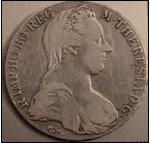
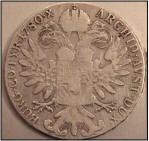
*** |
|
BUSTS ON
ROMAN COINS THAT MAY BE
FOUND IN BRITAIN
(5) |
 |
Maximinus 1 235-238.
C. Julius Verus Maximinus
was born of peasant stock in
Thrace. He was reputably a
man of great stature and
strength. The Historia
Augusta reports that he was
8’ 6” (2.6m) tall! He rose
through the ranks of the
army until in A.D. 235 he
seized the throne with the
aid of his legions. He was
on campaign for all his
reign, never once visiting
Rome. He was murdered with
his son, Maximus, in A.D.
238 by his troops.
GORDIAN 111 238—244.
M. Antonius Gordianus was
born about A.D. 225 he was
given the title Caesar by
the joint emperors Balbinus
and Pupienus After their
murders in A.D.238 he was
proclaimed Augustus by the
Praetorian guard although he
was only thirteen years of
age. At that tender age he
directed the Persian
campaigned with great
success but due to the
treachery of M. Julius
Philippus, the Praetorian
prefect, he was deposed and
murdered in Mesopotamia in
A.. 244.
PHILIP 1 244—249.
M. Julius Philippus (Philip
the Arab) was born in Arabia
in A.D. 204. After bringing
about the murder of Gordian
111 he became emperor in
A.D. 244. He made his son,
Philip, who was five years
of age Caesar. In A.D. 247
he raised him to the rank of
Augustus. In A. D. 249
Philip was killed in a
battle at Verona fighting
against the legions of
Trajan Decius. As soon as
the news of his death
reached Rome his son, who
was in the Praetorian camp,
was also killed.
TRAJAN DECIUS 249—251.
C. Messius Quintus Trajanus
Decius was born about A.D.
201 in the Balkan village of
Budalia, he gained
senatorial rank and became
governor of Lower Moesia.
Whilst putting down a
rebellion in Upper Moesia
his troops forced him to
seize the throne and march
on Italy. After the battle
of Verona he became emperor.
His short reign was ended
when he was killed with his
son, Herennius Etruscus
fighting the Goths in A.D.
251.
TREBONIANUS GALLUS 251-253.
C. Vibius Trebonianus Gallus
was born in A.D. 206 in
Perugia he attained high
rank in the army and after
the death of Decius he was
made emperor by the troops
in A. D. 251. His reign was
subject to many troubles
including the plague, even
his adopted son, Hostilianus,
died of it at Rome. Gallus
raised his own son,
Volusianus, to the rank of
emperor.
VOLUSIAN 251-253.
C. Vibius Afinius Gallus
Vendumnianus Volusianus, the
son of Trebonianus Gallus
was made emperor by his
father in A.D.253. Aemilius
Aemilianus was proclaimed
emperor by the legions after
a victory against the Goths.
Gallus marched from Rome to
meet Aemilian but when only
fifty miles north of Rome
both Gallus and Volusian
were murdered by their
troops who changed their
allegiance to Aemilian.
Shortly after Aemilian was
murdered in turn by the
troops.
*** |
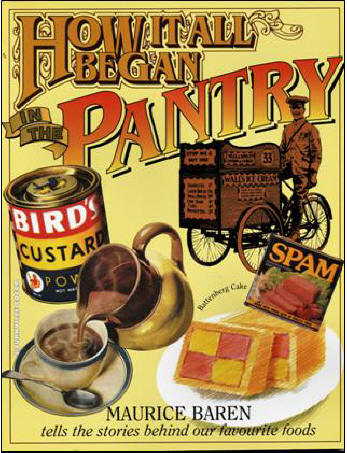 |
BOOKSHELF
In this issue of the
newsletter I would like
to introduce you to a
book I bought, for £1
about two years ago,
from a charity shop. It
is ‘How it all Began in
the Pantry’ by Maurice
Baren.
The cheapest copy I
can find on the internet
is £1.76 plus £1.99
postage, from Daleside
Books, Leeds.
This is a fascinating
book giving the origins
of more than five
hundred food products.
Beautifully illustrated
with over three hundred
photographs,
advertisements and
illustrations it is a
mouth-watering treat for
everyone.
Although not a ‘metal
detecting book’ how can
anyone resist finding
the origins of foods
like Humble Pie,
Gentlemen’s Relish and
Bombay Duck, to name but
a few explained in the
book?
JMBG.
|
|
GREAT
SEAL OF THE KING OF
ENGLAND
RICHARD 11,
1377—1399. |
|
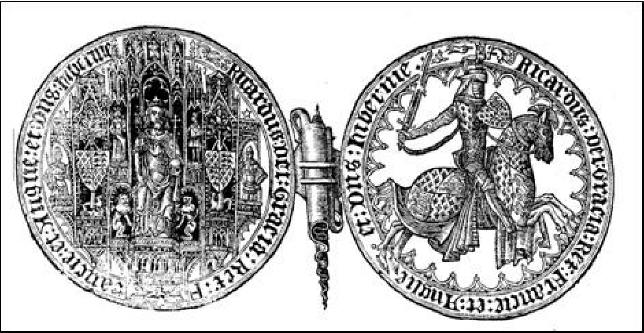 |
|
 |
ARTICLES WANTED FOR NEWSLETTER
The figure on the left is one of the older club members
thinking hard about an article for a future issue of the
club newsletter. He is not named for legal reasons.
Seriously, articles, suggestions,
photographs and ideas are urgently wanted for the
newsletter. Apart from two or three members who
contribute regularly, other club members do not seem to
be interested. The more contributions that come in, the
more frequently the newsletter can be issued.
If this photograph inspires anyone to do anything for
the newsletter please contact John Gough at a club
meeting, on a club search or by email to john.gough1@ntlworld.com.
Thank
you.
|
The Ashfield Metal Detecting Club reserve the
right not to be responsible for the
correctness, completeness or quality of the
information in this newsletter and does not,
necessarily, support the views of the
contributors.
|
***
|

